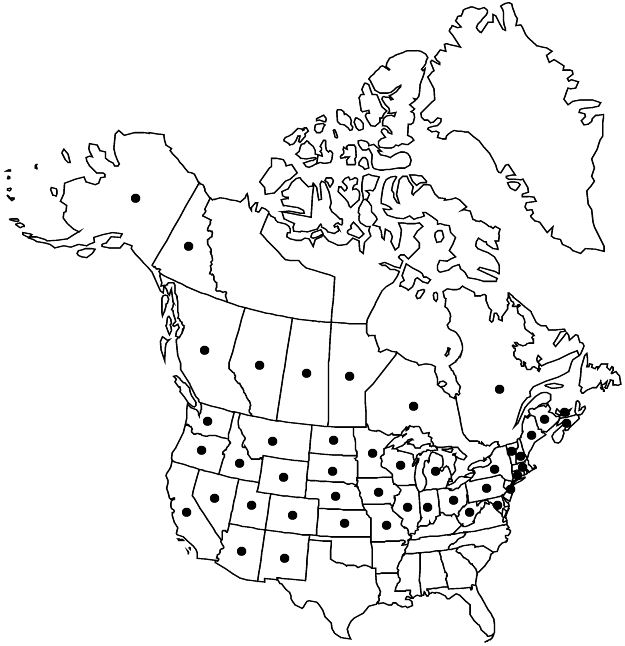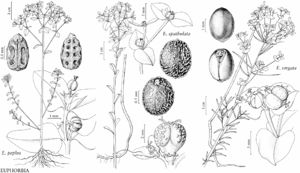Euphorbia virgata
Descr. Icon. Pl. Hung. 2: 176, plate 162. 1803.
Herbs, perennial, with slender, spreading rootstock. Stems erect, unbranched or branched, 20–90 cm, glabrous. Leaves: petiole 0–1 mm; blade linear to linear-oblanceolate or linear-oblong (margins parallel or almost parallel at midleaf), 40–90 × 3–12 mm, base truncate or abruptly attenuate, margins entire, apex acute or rounded, sometimes mucronulate, surfaces glabrous; venation inconspicuous, only midvein prominent. Cyathial arrangement: terminal pleiochasial branches 5–17, each 1–2 times 2-branched; pleiochasial bracts similar in shape to but shorter and wider than distal leaves; dichasial bracts distinct, broadly ovate, rhombic, or reniform, base cordate or cuneate, margins entire, apex obtuse to rounded, mucronulate; axillary cymose branches 0–18. Cyathia: peduncle 0–1 mm. Involucre campanulate, 1.5–3.5 × 1.7–3 mm, glabrous; glands 4, crescent-shaped, 0.6–1.5 × 1.3–2.5 mm; horns divergent to convergent, 0.2–0.8 mm. Staminate flowers 10–25. Pistillate flowers: ovary glabrous; styles 1.7–2.5 mm, 2-fid. Capsules subglobose, 2.5–3.5 × 3–4.5 mm, slightly lobed; cocci rounded, smooth except finely granulate toward abaxial line, glabrous; columella 2–3.3 mm. Seeds yellow-brown to gray or mottled, oblong-ellipsoid to oblong-ovoid, 2.2–2.6 × 1.3–1.6 mm, smooth; caruncle subconic, 0.6–1 × 0.7–0.9 mm. 2n = 60.
Phenology: Flowering and fruiting spring–fall.
Habitat: Pastures, fields, waste places, shorelines, railroads, open disturbed areas.
Elevation: 0–2600 m.
Distribution

Introduced; Alta., B.C., Man., N.B., N.S., Ont., P.E.I., Que., Sask., Yukon, Alaska, Ariz., Calif., Colo., Conn., Idaho, Ill., Ind., Iowa, Kans., Maine, Md., Mass., Mich., Minn., Mo., Mont., Nebr., Nev., N.H., N.J., N.Mex., N.Y., N.Dak., Ohio, Oreg., Pa., S.Dak., Utah, Vt., Wash., W.Va., Wis., Wyo., Europe, Asia.
Discussion
Euphorbia virgata has caused significant economic and ecological impact over large portions of the United States and Canada. It is part of a taxonomically complex group of species native to Europe and Asia, and there has been much confusion over the naming of the species that has become widely established in the New World (A. Radcliffe-Smith 1985; P. M. Catling and G. Mitrow 2012). There has been speculation that hybridization and polyploidy have played a role in the weediness of leafy spurge, and it is possible that the widespread occurrence of leafy spurge in North America is at least partly due to multiple introductions in grain imported from Eurasia (Ma J. S. 2010). Nonetheless, a re-evaluation of the leafy spurge complex by Berry et al. (unpubl.) revealed that E. esula Linnaeus and E. virgata are two distinct, albeit related species. The true E. esula is restricted in range to certain parts of Europe and shows little tendency toward weediness where it occurs. In contrast, E. virgata is much more widespread across Europe and temperate Asia, where it shows the same weedy characteristics as leafy spurge in the New World. More importantly, it is morphologically consistent with the North American material of leafy spurge.
According to D. V. Geltman (1998), the best way to distinguish morphologically between Euphorbia virgata and E. esula is by differences in their leaf shape. In E. virgata, the leaf blades are linear to linear-oblanceolate or linear-oblong, 6–15 times longer than wide, with margins that are parallel or almost parallel at the middle of the blade; the apex is usually acute, and the base is truncate or abruptly attenuate. In E. esula, the leaf blades are oblanceolate to obovate-elliptic (distinctly wider toward apex), 3–8(–10) times longer than wide, with margins not parallel at the middle of the leaf; the apex is rounded to subacute, and the base is gradually attenuate to cuneate.
There are some herbarium specimens of Euphorbia esula from North America that indicate it probably occurred sporadically in certain states in the late 1800s and early 1900s, but the authors have no evidence that it has persisted in any of those places. Therefore in this treatment, E. esula is considered to be a waif in the North American flora and, by excluding it here, the authors hope to avoid confusion between it and the widespread E. virgata.
Selected References
None.
